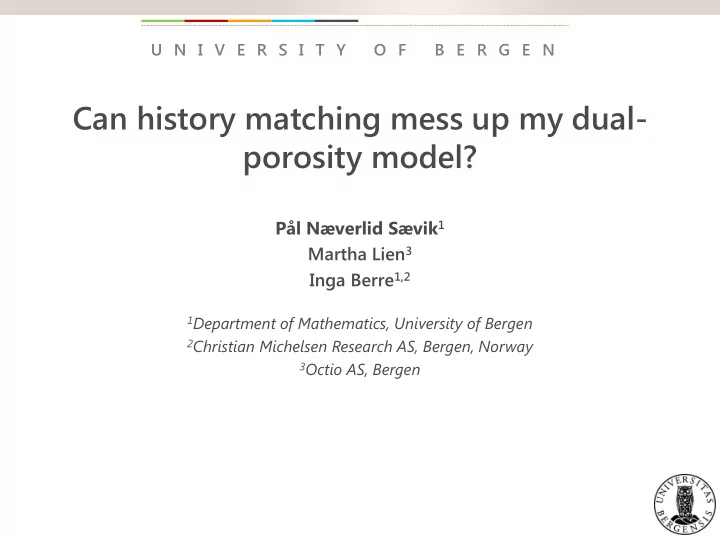

U N I V E R S I T Y O F B E R G E N Can history matching mess up my dual- porosity model? Pål Næverlid Sævik 1 Martha Lien 3 Inga Berre 1,2 1 Department of Mathematics, University of Bergen 2 Christian Michelsen Research AS, Bergen, Norway 3 Octio AS, Bergen
2
3 Motivation: Staying on the manifold What happens if you apply history matching on upscaled fracture parameters? Aperture Fracture density 𝒔 = Upscaling error Permeability Porosity 𝒔 = Transfer coefficient
4 Motivation: Staying on the manifold What happens if you apply history matching on upscaled fracture parameters? 𝑆 sin 𝜚 cos 𝜄 𝑆 sin 𝜚 sin 𝜄 𝒔 = 𝑆 cos 𝜚 𝑦 𝑧 𝒔 = 𝑨
5 EnKF biased towards Gaussian distributions True correlation True posterior 𝑞 𝑛 2 EnKF estimate EnKF estimate 𝑛 𝑛 1 Posterior Correlation probability
6 Choice of primary variables Aperture, fracture density, connectivity Adjust fracture parameters Adjust reservoir parameters Upscaling Permeability, porosity, transfer coefficient Simulation Pressure, flow rates, saturation Data comparison Mismatch
7 Fracture upscaling Analytical Numerical • Fast solution • Computationally expensive • Derivatives easily obtained • Technically difficult • Requires macroscopic • Potentially accurate homogeneity • Flexible formulation • May not be applicable to all geometries
8 Analytical fracture upscaling Layer-based Inclusion-based • Fractures are modeled as • Fractures are modeled as infinitely extending thin infinitely separated layers inclusions • Modifications are applied • Modifications are applied to account for partial to account for fracture connectivity interaction
9 Layer-based fracture upscaling • Permeability 𝑂 𝑏 3 𝜍 𝑗 ⊤ 𝐨 𝑗 𝐋 = 𝐋 𝑛𝑏𝑢 + 𝑔 𝑱 − 𝐨 𝑗 12 𝑗=1 • Porosity 𝑂 𝜚 = 𝑏 𝜍 𝑗 𝑗=1 • Transfer coefficient 𝜏 = 4 Tr 𝐒 ⊤ 𝐒 𝑂 ⊤ 𝐨 𝑗 𝐒 = 𝜍 𝑗 𝐨 𝑗 𝑗=1
10 A simple example • Randomly oriented, infinitely extending fractures • No permeability within the matrix • Exact upscaling assumed 𝐿 = 𝑏 3 𝜍 18 𝜚 = 𝑏𝜍 𝜏 = 4 3 𝜍 2 • Single simulation grid block • The inverse upscaling transform is well-defined
11 A simple example • Uniform distribution for the prior data • Measured data has gaussian noise
12 Three ways to get a history matched model
13 Post-analysis correlations Reservoir parameters Fracture parameters
14 Linear fracture upscaling ln 𝐿 = ln 𝑏 3 𝜍 18 ln 𝜚 = ln 𝑏𝜍 ln 𝜏 = ln 4 3 𝜍 2 Using log of the parameters as primary variables Upscaling transformation is linear, and connectivity is preserved
15 Fractures of finite size ln 𝐿 = ln 𝑔 𝑏 3 𝜍 Logaritmic reservoir parameters 18 ln 𝜚 = ln 𝑏𝜍 ln 𝜏 = ln 4 3 𝜍 2 Connectivity 𝑔 is calculated using a Fracture parameters method of Mourzenko et al. (2011) Upscaling transformation is nonlinear despite using logarithms
16 Effects of inexact upscaling method ln 𝐿 = ln 1 + 𝜀 𝑔 𝑏 3 𝜍 18 Reservoir parameters ln 𝜚 = ln 𝑏𝜍 ln 𝜏 = ln 4 3 𝜍 2 Logaritmic reservoir parameters
17 Effects of inexact upscaling method
18 Effects of inexact upscaling method
19 Does it matter for prediction? • Quarter-of-five-spot problem • Fracture parameters spatially correlated – Gaussian spatial covariance model – Correlation length ½ of domain size • Water injection, water-wet reservoir • Constant injection rate, constant production pressure • Assimilated data: – Volume production rate – Injection pressure – Water cut
20 Does it matter for prediction?
21 Concluding remarks • Using upscaled parameters as primary variables during inversion, may generate parameter distributions that are inconsistent with the underlying fracture description • The effect is most clearly seen for partially connected fracture networks, for which there exists an accurate upscaling relationship • The problem can be avoided by using fracture parameters as primary variables, and include upscaling as an integral part of the history matching workflow
Recommend
More recommend